Dissertation: Customer Satisfaction and Service Quality at Shangri-La
VerifiedAdded on 2019/12/03
|37
|12600
|66
Thesis and Dissertation
AI Summary
This dissertation investigates the conflict in perspective towards customer satisfaction and quality service, focusing on Shangri-La Hotel. The study explores the importance of quality service in the hospitality sector, examining its impact on customer satisfaction and the need for adapting to changing market trends. The research employs a descriptive and inductive approach, utilizing primary data from Shangri-La Hotel customers and secondary data from various sources. The study aims to assess Asian customer expectations, identify service provisions based on European standards, and evaluate potential cultural conflicts to recommend ways to minimize cultural gaps between customer satisfaction and service quality. The findings indicate that Shangri-La Hotel effectively meets its target market's requirements and manages the conflict between customer satisfaction and service quality. The dissertation recommends adopting new service quality improvement tools and conducting market research to understand cultural values, ultimately enhancing customer satisfaction and business growth.
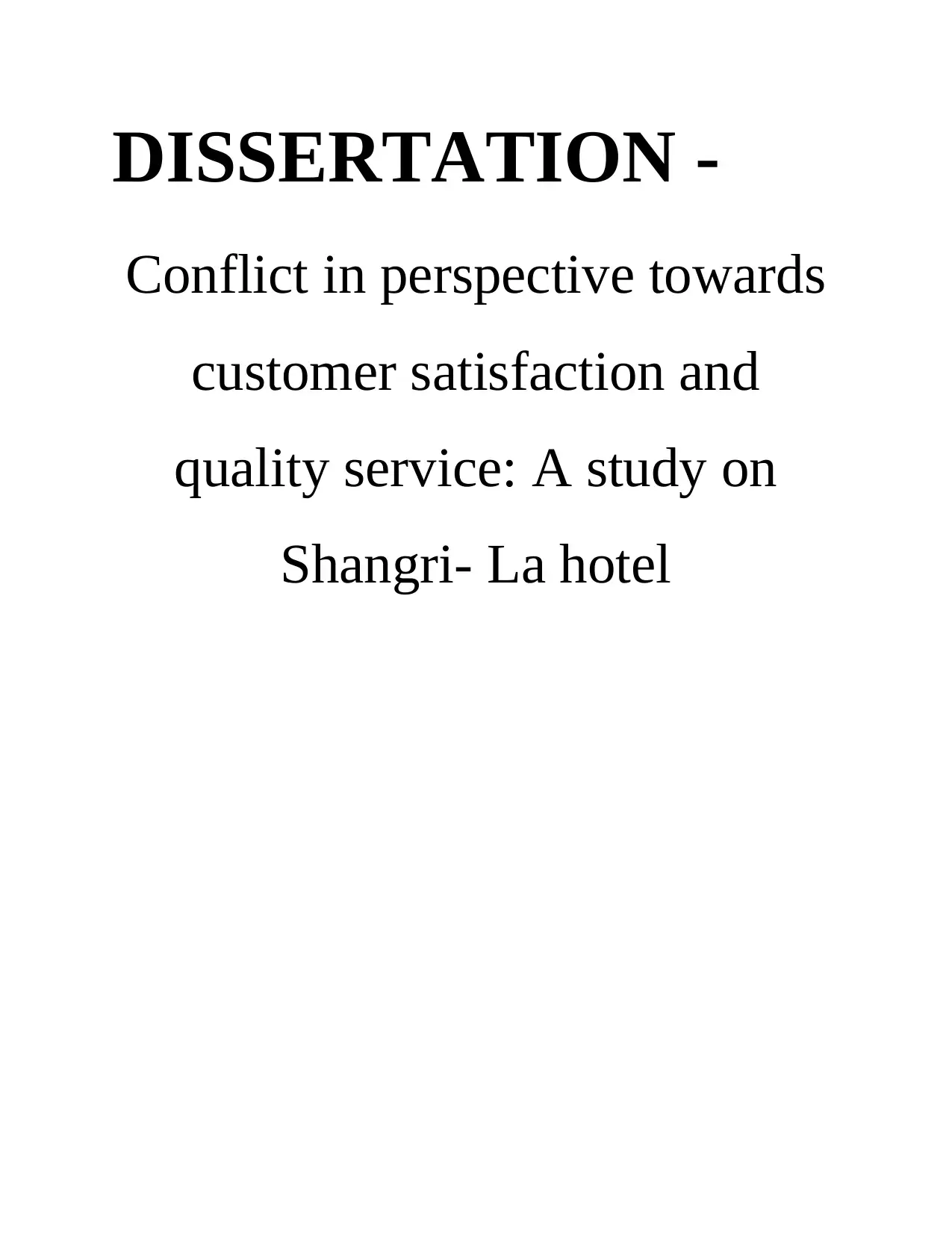
DISSERTATION -
Conflict in perspective towards
customer satisfaction and
quality service: A study on
Shangri- La hotel
Conflict in perspective towards
customer satisfaction and
quality service: A study on
Shangri- La hotel
Paraphrase This Document
Need a fresh take? Get an instant paraphrase of this document with our AI Paraphraser
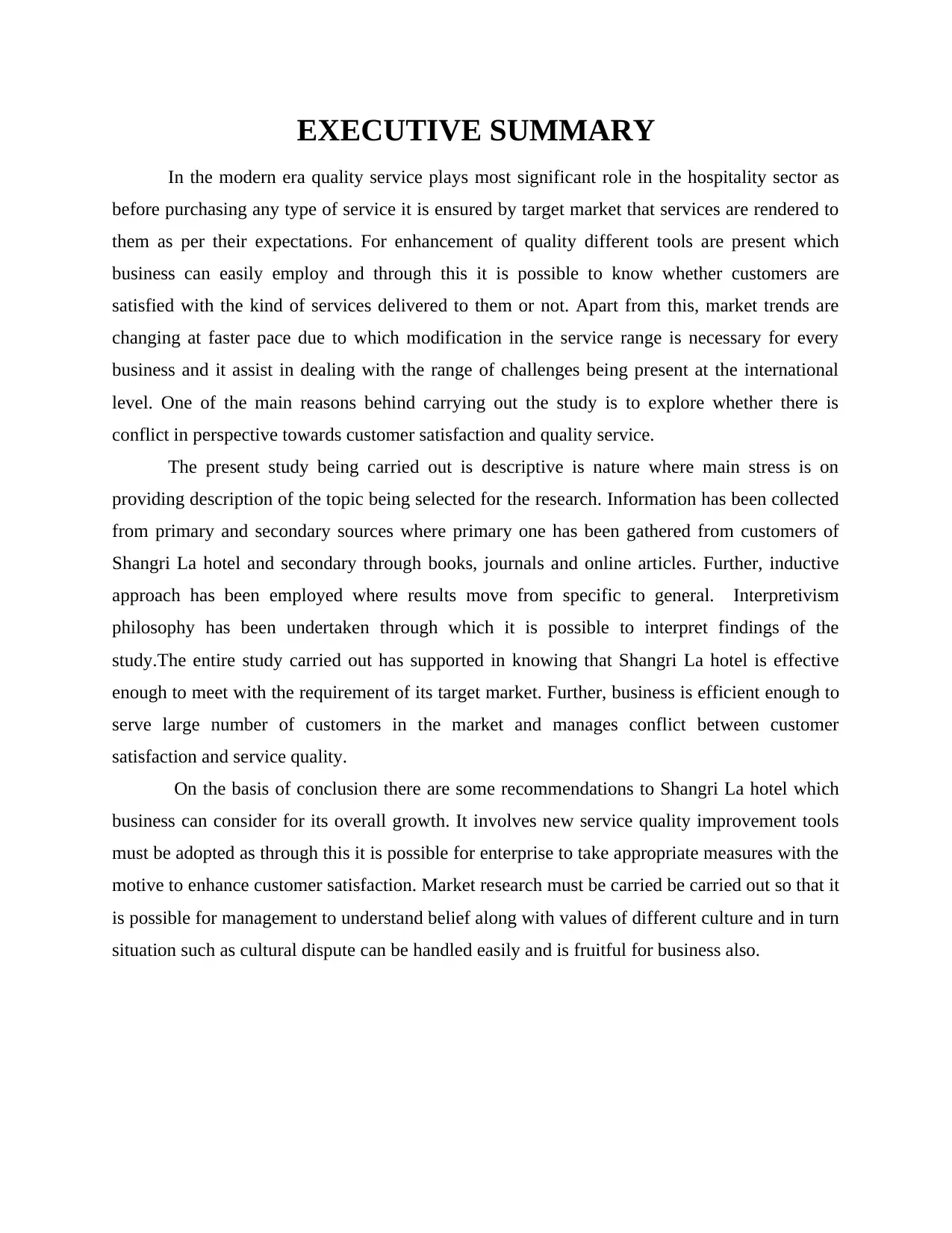
EXECUTIVE SUMMARY
In the modern era quality service plays most significant role in the hospitality sector as
before purchasing any type of service it is ensured by target market that services are rendered to
them as per their expectations. For enhancement of quality different tools are present which
business can easily employ and through this it is possible to know whether customers are
satisfied with the kind of services delivered to them or not. Apart from this, market trends are
changing at faster pace due to which modification in the service range is necessary for every
business and it assist in dealing with the range of challenges being present at the international
level. One of the main reasons behind carrying out the study is to explore whether there is
conflict in perspective towards customer satisfaction and quality service.
The present study being carried out is descriptive is nature where main stress is on
providing description of the topic being selected for the research. Information has been collected
from primary and secondary sources where primary one has been gathered from customers of
Shangri La hotel and secondary through books, journals and online articles. Further, inductive
approach has been employed where results move from specific to general. Interpretivism
philosophy has been undertaken through which it is possible to interpret findings of the
study.The entire study carried out has supported in knowing that Shangri La hotel is effective
enough to meet with the requirement of its target market. Further, business is efficient enough to
serve large number of customers in the market and manages conflict between customer
satisfaction and service quality.
On the basis of conclusion there are some recommendations to Shangri La hotel which
business can consider for its overall growth. It involves new service quality improvement tools
must be adopted as through this it is possible for enterprise to take appropriate measures with the
motive to enhance customer satisfaction. Market research must be carried be carried out so that it
is possible for management to understand belief along with values of different culture and in turn
situation such as cultural dispute can be handled easily and is fruitful for business also.
In the modern era quality service plays most significant role in the hospitality sector as
before purchasing any type of service it is ensured by target market that services are rendered to
them as per their expectations. For enhancement of quality different tools are present which
business can easily employ and through this it is possible to know whether customers are
satisfied with the kind of services delivered to them or not. Apart from this, market trends are
changing at faster pace due to which modification in the service range is necessary for every
business and it assist in dealing with the range of challenges being present at the international
level. One of the main reasons behind carrying out the study is to explore whether there is
conflict in perspective towards customer satisfaction and quality service.
The present study being carried out is descriptive is nature where main stress is on
providing description of the topic being selected for the research. Information has been collected
from primary and secondary sources where primary one has been gathered from customers of
Shangri La hotel and secondary through books, journals and online articles. Further, inductive
approach has been employed where results move from specific to general. Interpretivism
philosophy has been undertaken through which it is possible to interpret findings of the
study.The entire study carried out has supported in knowing that Shangri La hotel is effective
enough to meet with the requirement of its target market. Further, business is efficient enough to
serve large number of customers in the market and manages conflict between customer
satisfaction and service quality.
On the basis of conclusion there are some recommendations to Shangri La hotel which
business can consider for its overall growth. It involves new service quality improvement tools
must be adopted as through this it is possible for enterprise to take appropriate measures with the
motive to enhance customer satisfaction. Market research must be carried be carried out so that it
is possible for management to understand belief along with values of different culture and in turn
situation such as cultural dispute can be handled easily and is fruitful for business also.
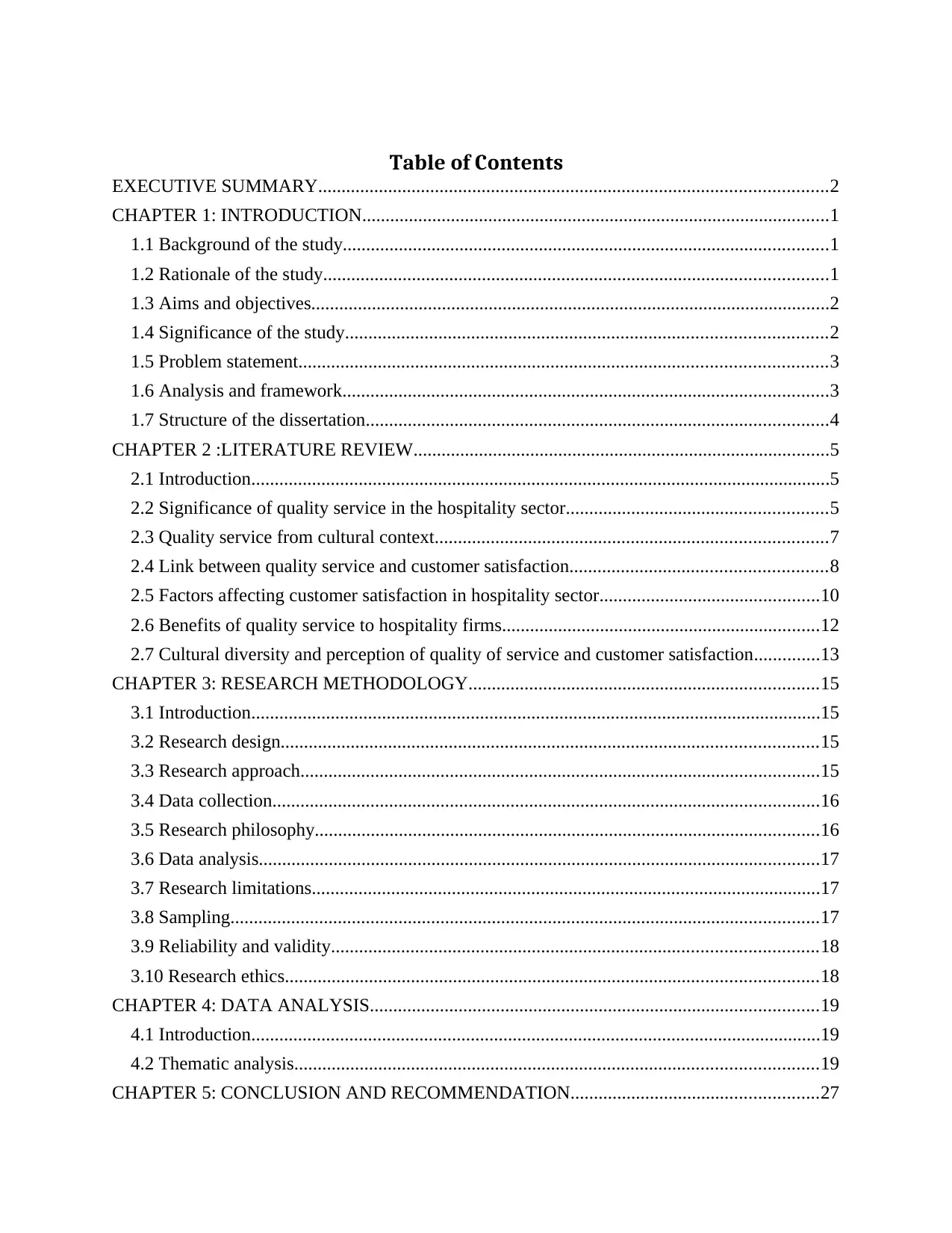
Table of Contents
EXECUTIVE SUMMARY.............................................................................................................2
CHAPTER 1: INTRODUCTION....................................................................................................1
1.1 Background of the study........................................................................................................1
1.2 Rationale of the study............................................................................................................1
1.3 Aims and objectives...............................................................................................................2
1.4 Significance of the study.......................................................................................................2
1.5 Problem statement.................................................................................................................3
1.6 Analysis and framework........................................................................................................3
1.7 Structure of the dissertation...................................................................................................4
CHAPTER 2 :LITERATURE REVIEW.........................................................................................5
2.1 Introduction............................................................................................................................5
2.2 Significance of quality service in the hospitality sector........................................................5
2.3 Quality service from cultural context....................................................................................7
2.4 Link between quality service and customer satisfaction.......................................................8
2.5 Factors affecting customer satisfaction in hospitality sector...............................................10
2.6 Benefits of quality service to hospitality firms....................................................................12
2.7 Cultural diversity and perception of quality of service and customer satisfaction..............13
CHAPTER 3: RESEARCH METHODOLOGY...........................................................................15
3.1 Introduction..........................................................................................................................15
3.2 Research design...................................................................................................................15
3.3 Research approach...............................................................................................................15
3.4 Data collection.....................................................................................................................16
3.5 Research philosophy............................................................................................................16
3.6 Data analysis........................................................................................................................17
3.7 Research limitations.............................................................................................................17
3.8 Sampling..............................................................................................................................17
3.9 Reliability and validity........................................................................................................18
3.10 Research ethics..................................................................................................................18
CHAPTER 4: DATA ANALYSIS................................................................................................19
4.1 Introduction..........................................................................................................................19
4.2 Thematic analysis................................................................................................................19
CHAPTER 5: CONCLUSION AND RECOMMENDATION.....................................................27
EXECUTIVE SUMMARY.............................................................................................................2
CHAPTER 1: INTRODUCTION....................................................................................................1
1.1 Background of the study........................................................................................................1
1.2 Rationale of the study............................................................................................................1
1.3 Aims and objectives...............................................................................................................2
1.4 Significance of the study.......................................................................................................2
1.5 Problem statement.................................................................................................................3
1.6 Analysis and framework........................................................................................................3
1.7 Structure of the dissertation...................................................................................................4
CHAPTER 2 :LITERATURE REVIEW.........................................................................................5
2.1 Introduction............................................................................................................................5
2.2 Significance of quality service in the hospitality sector........................................................5
2.3 Quality service from cultural context....................................................................................7
2.4 Link between quality service and customer satisfaction.......................................................8
2.5 Factors affecting customer satisfaction in hospitality sector...............................................10
2.6 Benefits of quality service to hospitality firms....................................................................12
2.7 Cultural diversity and perception of quality of service and customer satisfaction..............13
CHAPTER 3: RESEARCH METHODOLOGY...........................................................................15
3.1 Introduction..........................................................................................................................15
3.2 Research design...................................................................................................................15
3.3 Research approach...............................................................................................................15
3.4 Data collection.....................................................................................................................16
3.5 Research philosophy............................................................................................................16
3.6 Data analysis........................................................................................................................17
3.7 Research limitations.............................................................................................................17
3.8 Sampling..............................................................................................................................17
3.9 Reliability and validity........................................................................................................18
3.10 Research ethics..................................................................................................................18
CHAPTER 4: DATA ANALYSIS................................................................................................19
4.1 Introduction..........................................................................................................................19
4.2 Thematic analysis................................................................................................................19
CHAPTER 5: CONCLUSION AND RECOMMENDATION.....................................................27
⊘ This is a preview!⊘
Do you want full access?
Subscribe today to unlock all pages.

Trusted by 1+ million students worldwide

5.1 Introduction..........................................................................................................................27
5.2 Conclusion...........................................................................................................................27
5.3 Recommendations................................................................................................................29
REFERENCES..............................................................................................................................31
APPENDIX....................................................................................................................................33
5.2 Conclusion...........................................................................................................................27
5.3 Recommendations................................................................................................................29
REFERENCES..............................................................................................................................31
APPENDIX....................................................................................................................................33
Paraphrase This Document
Need a fresh take? Get an instant paraphrase of this document with our AI Paraphraser
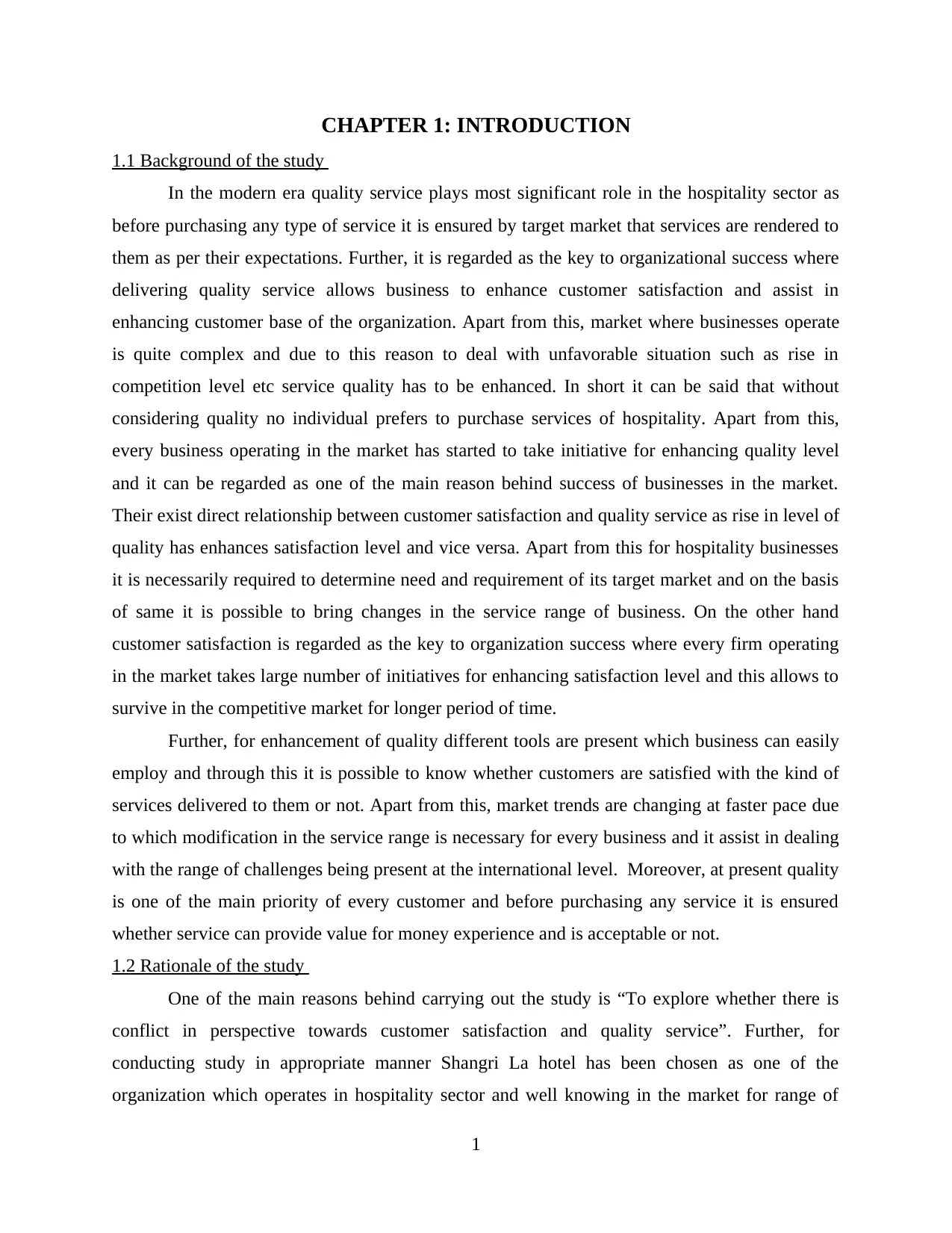
CHAPTER 1: INTRODUCTION
1.1 Background of the study
In the modern era quality service plays most significant role in the hospitality sector as
before purchasing any type of service it is ensured by target market that services are rendered to
them as per their expectations. Further, it is regarded as the key to organizational success where
delivering quality service allows business to enhance customer satisfaction and assist in
enhancing customer base of the organization. Apart from this, market where businesses operate
is quite complex and due to this reason to deal with unfavorable situation such as rise in
competition level etc service quality has to be enhanced. In short it can be said that without
considering quality no individual prefers to purchase services of hospitality. Apart from this,
every business operating in the market has started to take initiative for enhancing quality level
and it can be regarded as one of the main reason behind success of businesses in the market.
Their exist direct relationship between customer satisfaction and quality service as rise in level of
quality has enhances satisfaction level and vice versa. Apart from this for hospitality businesses
it is necessarily required to determine need and requirement of its target market and on the basis
of same it is possible to bring changes in the service range of business. On the other hand
customer satisfaction is regarded as the key to organization success where every firm operating
in the market takes large number of initiatives for enhancing satisfaction level and this allows to
survive in the competitive market for longer period of time.
Further, for enhancement of quality different tools are present which business can easily
employ and through this it is possible to know whether customers are satisfied with the kind of
services delivered to them or not. Apart from this, market trends are changing at faster pace due
to which modification in the service range is necessary for every business and it assist in dealing
with the range of challenges being present at the international level. Moreover, at present quality
is one of the main priority of every customer and before purchasing any service it is ensured
whether service can provide value for money experience and is acceptable or not.
1.2 Rationale of the study
One of the main reasons behind carrying out the study is “To explore whether there is
conflict in perspective towards customer satisfaction and quality service”. Further, for
conducting study in appropriate manner Shangri La hotel has been chosen as one of the
organization which operates in hospitality sector and well knowing in the market for range of
1
1.1 Background of the study
In the modern era quality service plays most significant role in the hospitality sector as
before purchasing any type of service it is ensured by target market that services are rendered to
them as per their expectations. Further, it is regarded as the key to organizational success where
delivering quality service allows business to enhance customer satisfaction and assist in
enhancing customer base of the organization. Apart from this, market where businesses operate
is quite complex and due to this reason to deal with unfavorable situation such as rise in
competition level etc service quality has to be enhanced. In short it can be said that without
considering quality no individual prefers to purchase services of hospitality. Apart from this,
every business operating in the market has started to take initiative for enhancing quality level
and it can be regarded as one of the main reason behind success of businesses in the market.
Their exist direct relationship between customer satisfaction and quality service as rise in level of
quality has enhances satisfaction level and vice versa. Apart from this for hospitality businesses
it is necessarily required to determine need and requirement of its target market and on the basis
of same it is possible to bring changes in the service range of business. On the other hand
customer satisfaction is regarded as the key to organization success where every firm operating
in the market takes large number of initiatives for enhancing satisfaction level and this allows to
survive in the competitive market for longer period of time.
Further, for enhancement of quality different tools are present which business can easily
employ and through this it is possible to know whether customers are satisfied with the kind of
services delivered to them or not. Apart from this, market trends are changing at faster pace due
to which modification in the service range is necessary for every business and it assist in dealing
with the range of challenges being present at the international level. Moreover, at present quality
is one of the main priority of every customer and before purchasing any service it is ensured
whether service can provide value for money experience and is acceptable or not.
1.2 Rationale of the study
One of the main reasons behind carrying out the study is “To explore whether there is
conflict in perspective towards customer satisfaction and quality service”. Further, for
conducting study in appropriate manner Shangri La hotel has been chosen as one of the
organization which operates in hospitality sector and well knowing in the market for range of
1
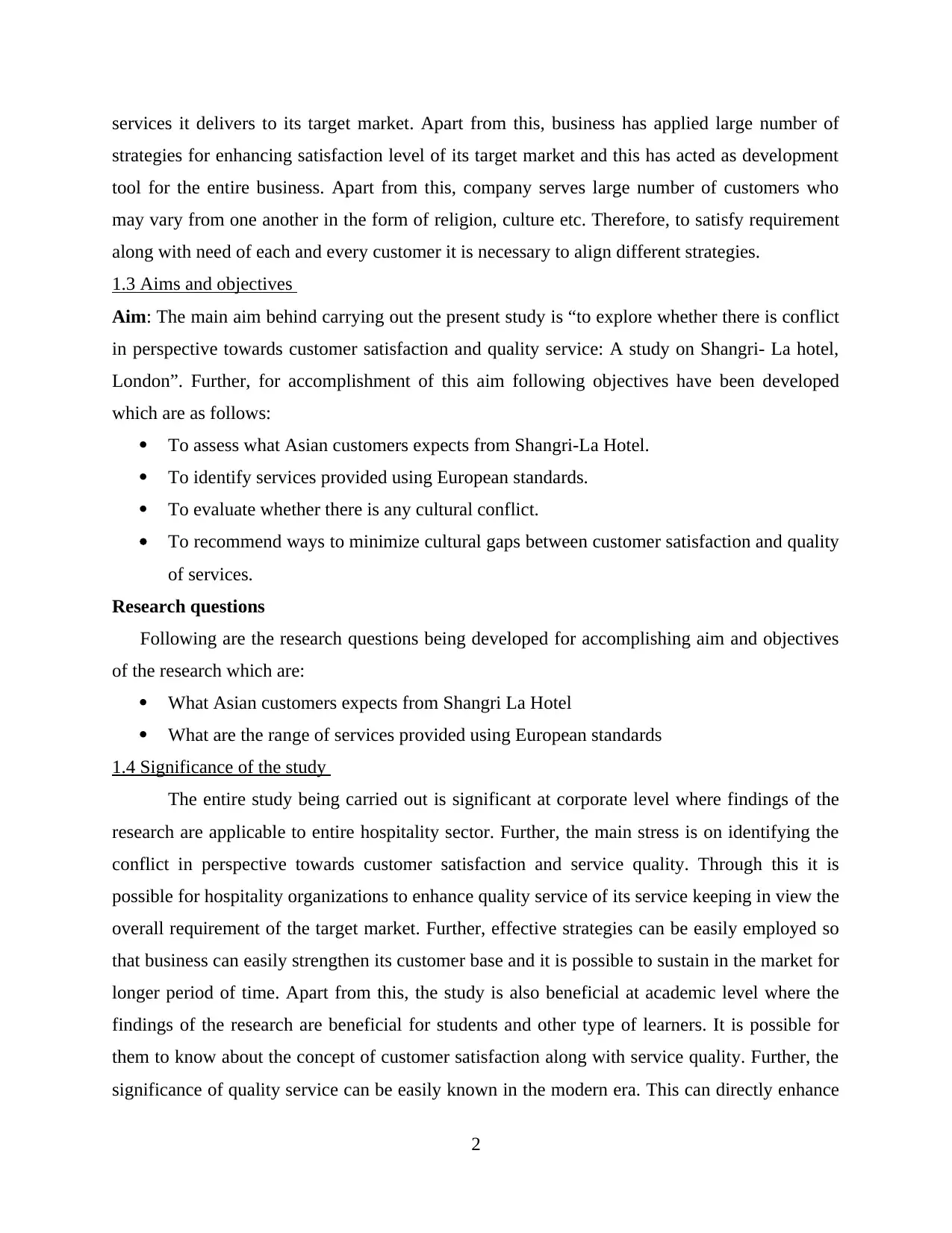
services it delivers to its target market. Apart from this, business has applied large number of
strategies for enhancing satisfaction level of its target market and this has acted as development
tool for the entire business. Apart from this, company serves large number of customers who
may vary from one another in the form of religion, culture etc. Therefore, to satisfy requirement
along with need of each and every customer it is necessary to align different strategies.
1.3 Aims and objectives
Aim: The main aim behind carrying out the present study is “to explore whether there is conflict
in perspective towards customer satisfaction and quality service: A study on Shangri- La hotel,
London”. Further, for accomplishment of this aim following objectives have been developed
which are as follows:
To assess what Asian customers expects from Shangri-La Hotel.
To identify services provided using European standards.
To evaluate whether there is any cultural conflict.
To recommend ways to minimize cultural gaps between customer satisfaction and quality
of services.
Research questions
Following are the research questions being developed for accomplishing aim and objectives
of the research which are:
What Asian customers expects from Shangri La Hotel
What are the range of services provided using European standards
1.4 Significance of the study
The entire study being carried out is significant at corporate level where findings of the
research are applicable to entire hospitality sector. Further, the main stress is on identifying the
conflict in perspective towards customer satisfaction and service quality. Through this it is
possible for hospitality organizations to enhance quality service of its service keeping in view the
overall requirement of the target market. Further, effective strategies can be easily employed so
that business can easily strengthen its customer base and it is possible to sustain in the market for
longer period of time. Apart from this, the study is also beneficial at academic level where the
findings of the research are beneficial for students and other type of learners. It is possible for
them to know about the concept of customer satisfaction along with service quality. Further, the
significance of quality service can be easily known in the modern era. This can directly enhance
2
strategies for enhancing satisfaction level of its target market and this has acted as development
tool for the entire business. Apart from this, company serves large number of customers who
may vary from one another in the form of religion, culture etc. Therefore, to satisfy requirement
along with need of each and every customer it is necessary to align different strategies.
1.3 Aims and objectives
Aim: The main aim behind carrying out the present study is “to explore whether there is conflict
in perspective towards customer satisfaction and quality service: A study on Shangri- La hotel,
London”. Further, for accomplishment of this aim following objectives have been developed
which are as follows:
To assess what Asian customers expects from Shangri-La Hotel.
To identify services provided using European standards.
To evaluate whether there is any cultural conflict.
To recommend ways to minimize cultural gaps between customer satisfaction and quality
of services.
Research questions
Following are the research questions being developed for accomplishing aim and objectives
of the research which are:
What Asian customers expects from Shangri La Hotel
What are the range of services provided using European standards
1.4 Significance of the study
The entire study being carried out is significant at corporate level where findings of the
research are applicable to entire hospitality sector. Further, the main stress is on identifying the
conflict in perspective towards customer satisfaction and service quality. Through this it is
possible for hospitality organizations to enhance quality service of its service keeping in view the
overall requirement of the target market. Further, effective strategies can be easily employed so
that business can easily strengthen its customer base and it is possible to sustain in the market for
longer period of time. Apart from this, the study is also beneficial at academic level where the
findings of the research are beneficial for students and other type of learners. It is possible for
them to know about the concept of customer satisfaction along with service quality. Further, the
significance of quality service can be easily known in the modern era. This can directly enhance
2
⊘ This is a preview!⊘
Do you want full access?
Subscribe today to unlock all pages.

Trusted by 1+ million students worldwide
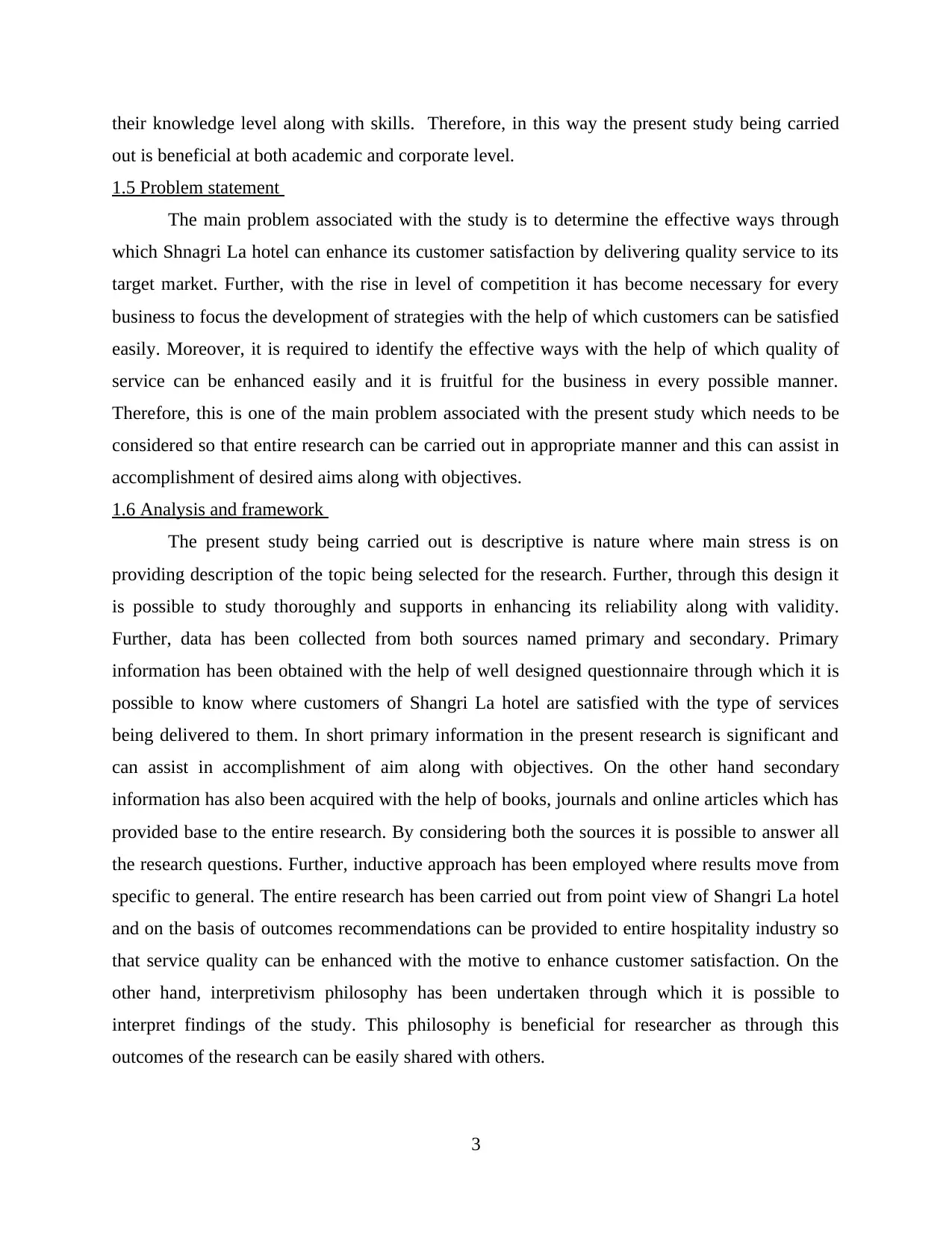
their knowledge level along with skills. Therefore, in this way the present study being carried
out is beneficial at both academic and corporate level.
1.5 Problem statement
The main problem associated with the study is to determine the effective ways through
which Shnagri La hotel can enhance its customer satisfaction by delivering quality service to its
target market. Further, with the rise in level of competition it has become necessary for every
business to focus the development of strategies with the help of which customers can be satisfied
easily. Moreover, it is required to identify the effective ways with the help of which quality of
service can be enhanced easily and it is fruitful for the business in every possible manner.
Therefore, this is one of the main problem associated with the present study which needs to be
considered so that entire research can be carried out in appropriate manner and this can assist in
accomplishment of desired aims along with objectives.
1.6 Analysis and framework
The present study being carried out is descriptive is nature where main stress is on
providing description of the topic being selected for the research. Further, through this design it
is possible to study thoroughly and supports in enhancing its reliability along with validity.
Further, data has been collected from both sources named primary and secondary. Primary
information has been obtained with the help of well designed questionnaire through which it is
possible to know where customers of Shangri La hotel are satisfied with the type of services
being delivered to them. In short primary information in the present research is significant and
can assist in accomplishment of aim along with objectives. On the other hand secondary
information has also been acquired with the help of books, journals and online articles which has
provided base to the entire research. By considering both the sources it is possible to answer all
the research questions. Further, inductive approach has been employed where results move from
specific to general. The entire research has been carried out from point view of Shangri La hotel
and on the basis of outcomes recommendations can be provided to entire hospitality industry so
that service quality can be enhanced with the motive to enhance customer satisfaction. On the
other hand, interpretivism philosophy has been undertaken through which it is possible to
interpret findings of the study. This philosophy is beneficial for researcher as through this
outcomes of the research can be easily shared with others.
3
out is beneficial at both academic and corporate level.
1.5 Problem statement
The main problem associated with the study is to determine the effective ways through
which Shnagri La hotel can enhance its customer satisfaction by delivering quality service to its
target market. Further, with the rise in level of competition it has become necessary for every
business to focus the development of strategies with the help of which customers can be satisfied
easily. Moreover, it is required to identify the effective ways with the help of which quality of
service can be enhanced easily and it is fruitful for the business in every possible manner.
Therefore, this is one of the main problem associated with the present study which needs to be
considered so that entire research can be carried out in appropriate manner and this can assist in
accomplishment of desired aims along with objectives.
1.6 Analysis and framework
The present study being carried out is descriptive is nature where main stress is on
providing description of the topic being selected for the research. Further, through this design it
is possible to study thoroughly and supports in enhancing its reliability along with validity.
Further, data has been collected from both sources named primary and secondary. Primary
information has been obtained with the help of well designed questionnaire through which it is
possible to know where customers of Shangri La hotel are satisfied with the type of services
being delivered to them. In short primary information in the present research is significant and
can assist in accomplishment of aim along with objectives. On the other hand secondary
information has also been acquired with the help of books, journals and online articles which has
provided base to the entire research. By considering both the sources it is possible to answer all
the research questions. Further, inductive approach has been employed where results move from
specific to general. The entire research has been carried out from point view of Shangri La hotel
and on the basis of outcomes recommendations can be provided to entire hospitality industry so
that service quality can be enhanced with the motive to enhance customer satisfaction. On the
other hand, interpretivism philosophy has been undertaken through which it is possible to
interpret findings of the study. This philosophy is beneficial for researcher as through this
outcomes of the research can be easily shared with others.
3
Paraphrase This Document
Need a fresh take? Get an instant paraphrase of this document with our AI Paraphraser
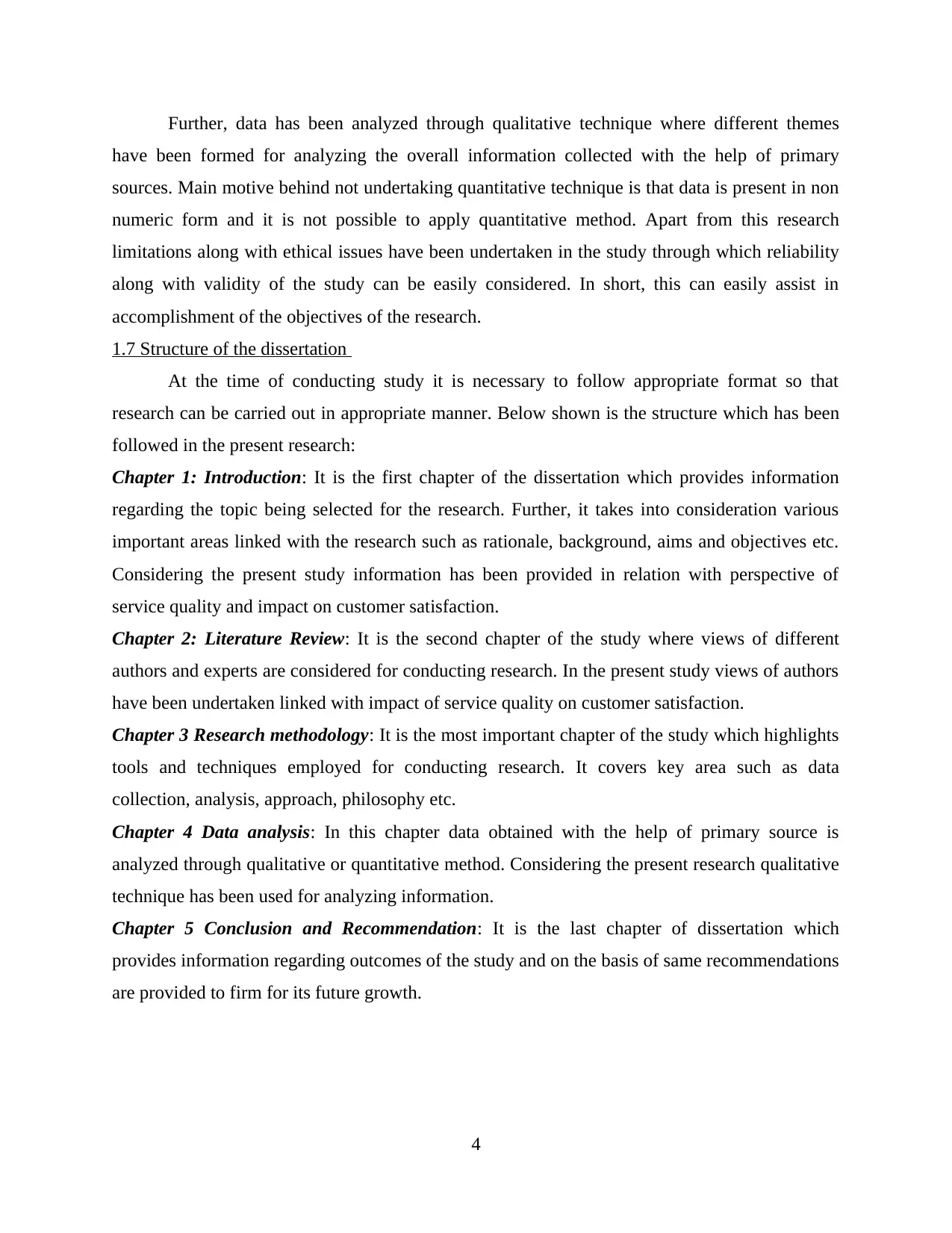
Further, data has been analyzed through qualitative technique where different themes
have been formed for analyzing the overall information collected with the help of primary
sources. Main motive behind not undertaking quantitative technique is that data is present in non
numeric form and it is not possible to apply quantitative method. Apart from this research
limitations along with ethical issues have been undertaken in the study through which reliability
along with validity of the study can be easily considered. In short, this can easily assist in
accomplishment of the objectives of the research.
1.7 Structure of the dissertation
At the time of conducting study it is necessary to follow appropriate format so that
research can be carried out in appropriate manner. Below shown is the structure which has been
followed in the present research:
Chapter 1: Introduction: It is the first chapter of the dissertation which provides information
regarding the topic being selected for the research. Further, it takes into consideration various
important areas linked with the research such as rationale, background, aims and objectives etc.
Considering the present study information has been provided in relation with perspective of
service quality and impact on customer satisfaction.
Chapter 2: Literature Review: It is the second chapter of the study where views of different
authors and experts are considered for conducting research. In the present study views of authors
have been undertaken linked with impact of service quality on customer satisfaction.
Chapter 3 Research methodology: It is the most important chapter of the study which highlights
tools and techniques employed for conducting research. It covers key area such as data
collection, analysis, approach, philosophy etc.
Chapter 4 Data analysis: In this chapter data obtained with the help of primary source is
analyzed through qualitative or quantitative method. Considering the present research qualitative
technique has been used for analyzing information.
Chapter 5 Conclusion and Recommendation: It is the last chapter of dissertation which
provides information regarding outcomes of the study and on the basis of same recommendations
are provided to firm for its future growth.
4
have been formed for analyzing the overall information collected with the help of primary
sources. Main motive behind not undertaking quantitative technique is that data is present in non
numeric form and it is not possible to apply quantitative method. Apart from this research
limitations along with ethical issues have been undertaken in the study through which reliability
along with validity of the study can be easily considered. In short, this can easily assist in
accomplishment of the objectives of the research.
1.7 Structure of the dissertation
At the time of conducting study it is necessary to follow appropriate format so that
research can be carried out in appropriate manner. Below shown is the structure which has been
followed in the present research:
Chapter 1: Introduction: It is the first chapter of the dissertation which provides information
regarding the topic being selected for the research. Further, it takes into consideration various
important areas linked with the research such as rationale, background, aims and objectives etc.
Considering the present study information has been provided in relation with perspective of
service quality and impact on customer satisfaction.
Chapter 2: Literature Review: It is the second chapter of the study where views of different
authors and experts are considered for conducting research. In the present study views of authors
have been undertaken linked with impact of service quality on customer satisfaction.
Chapter 3 Research methodology: It is the most important chapter of the study which highlights
tools and techniques employed for conducting research. It covers key area such as data
collection, analysis, approach, philosophy etc.
Chapter 4 Data analysis: In this chapter data obtained with the help of primary source is
analyzed through qualitative or quantitative method. Considering the present research qualitative
technique has been used for analyzing information.
Chapter 5 Conclusion and Recommendation: It is the last chapter of dissertation which
provides information regarding outcomes of the study and on the basis of same recommendations
are provided to firm for its future growth.
4
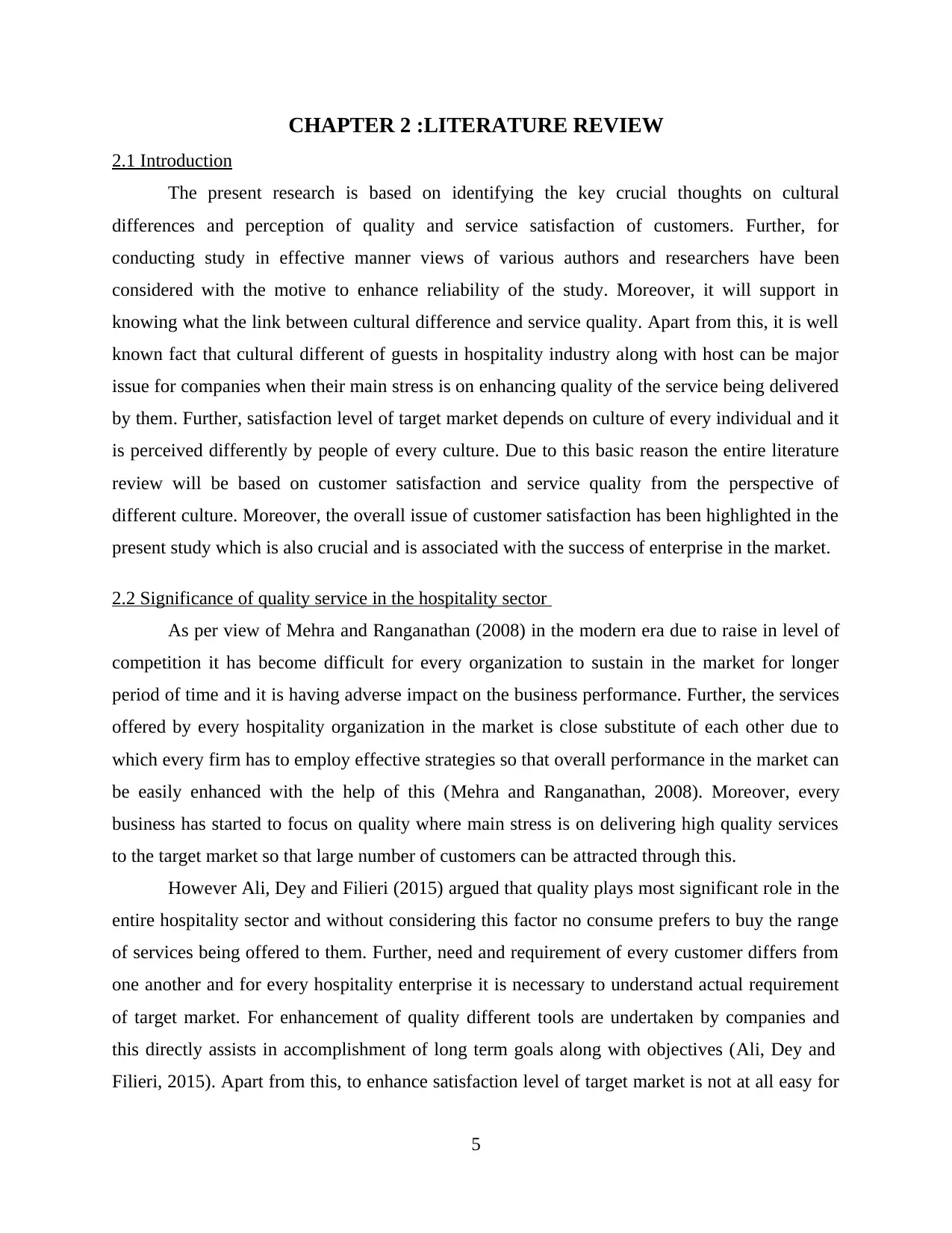
CHAPTER 2 :LITERATURE REVIEW
2.1 Introduction
The present research is based on identifying the key crucial thoughts on cultural
differences and perception of quality and service satisfaction of customers. Further, for
conducting study in effective manner views of various authors and researchers have been
considered with the motive to enhance reliability of the study. Moreover, it will support in
knowing what the link between cultural difference and service quality. Apart from this, it is well
known fact that cultural different of guests in hospitality industry along with host can be major
issue for companies when their main stress is on enhancing quality of the service being delivered
by them. Further, satisfaction level of target market depends on culture of every individual and it
is perceived differently by people of every culture. Due to this basic reason the entire literature
review will be based on customer satisfaction and service quality from the perspective of
different culture. Moreover, the overall issue of customer satisfaction has been highlighted in the
present study which is also crucial and is associated with the success of enterprise in the market.
2.2 Significance of quality service in the hospitality sector
As per view of Mehra and Ranganathan (2008) in the modern era due to raise in level of
competition it has become difficult for every organization to sustain in the market for longer
period of time and it is having adverse impact on the business performance. Further, the services
offered by every hospitality organization in the market is close substitute of each other due to
which every firm has to employ effective strategies so that overall performance in the market can
be easily enhanced with the help of this (Mehra and Ranganathan, 2008). Moreover, every
business has started to focus on quality where main stress is on delivering high quality services
to the target market so that large number of customers can be attracted through this.
However Ali, Dey and Filieri (2015) argued that quality plays most significant role in the
entire hospitality sector and without considering this factor no consume prefers to buy the range
of services being offered to them. Further, need and requirement of every customer differs from
one another and for every hospitality enterprise it is necessary to understand actual requirement
of target market. For enhancement of quality different tools are undertaken by companies and
this directly assists in accomplishment of long term goals along with objectives (Ali, Dey and
Filieri, 2015). Apart from this, to enhance satisfaction level of target market is not at all easy for
5
2.1 Introduction
The present research is based on identifying the key crucial thoughts on cultural
differences and perception of quality and service satisfaction of customers. Further, for
conducting study in effective manner views of various authors and researchers have been
considered with the motive to enhance reliability of the study. Moreover, it will support in
knowing what the link between cultural difference and service quality. Apart from this, it is well
known fact that cultural different of guests in hospitality industry along with host can be major
issue for companies when their main stress is on enhancing quality of the service being delivered
by them. Further, satisfaction level of target market depends on culture of every individual and it
is perceived differently by people of every culture. Due to this basic reason the entire literature
review will be based on customer satisfaction and service quality from the perspective of
different culture. Moreover, the overall issue of customer satisfaction has been highlighted in the
present study which is also crucial and is associated with the success of enterprise in the market.
2.2 Significance of quality service in the hospitality sector
As per view of Mehra and Ranganathan (2008) in the modern era due to raise in level of
competition it has become difficult for every organization to sustain in the market for longer
period of time and it is having adverse impact on the business performance. Further, the services
offered by every hospitality organization in the market is close substitute of each other due to
which every firm has to employ effective strategies so that overall performance in the market can
be easily enhanced with the help of this (Mehra and Ranganathan, 2008). Moreover, every
business has started to focus on quality where main stress is on delivering high quality services
to the target market so that large number of customers can be attracted through this.
However Ali, Dey and Filieri (2015) argued that quality plays most significant role in the
entire hospitality sector and without considering this factor no consume prefers to buy the range
of services being offered to them. Further, need and requirement of every customer differs from
one another and for every hospitality enterprise it is necessary to understand actual requirement
of target market. For enhancement of quality different tools are undertaken by companies and
this directly assists in accomplishment of long term goals along with objectives (Ali, Dey and
Filieri, 2015). Apart from this, to enhance satisfaction level of target market is not at all easy for
5
⊘ This is a preview!⊘
Do you want full access?
Subscribe today to unlock all pages.

Trusted by 1+ million students worldwide
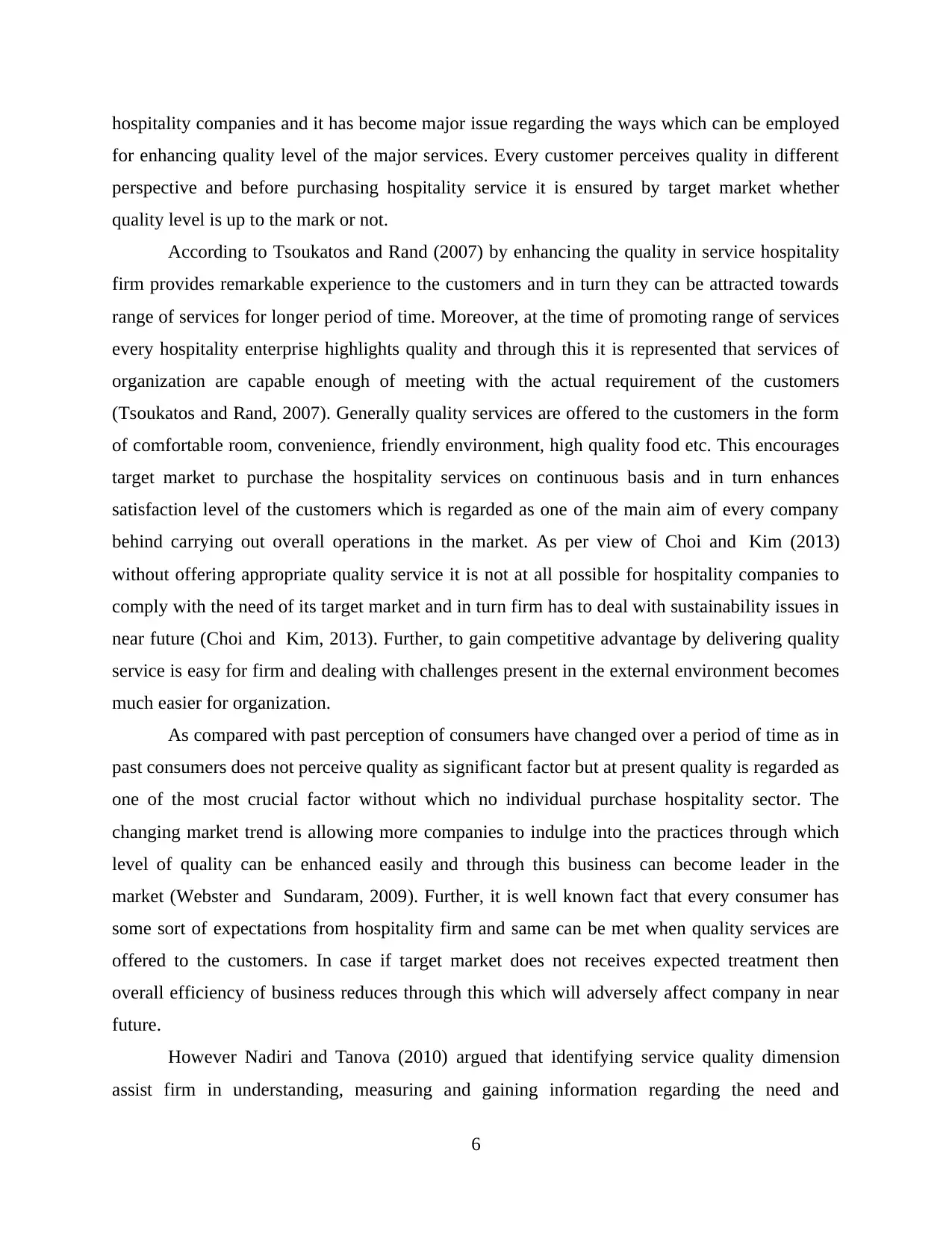
hospitality companies and it has become major issue regarding the ways which can be employed
for enhancing quality level of the major services. Every customer perceives quality in different
perspective and before purchasing hospitality service it is ensured by target market whether
quality level is up to the mark or not.
According to Tsoukatos and Rand (2007) by enhancing the quality in service hospitality
firm provides remarkable experience to the customers and in turn they can be attracted towards
range of services for longer period of time. Moreover, at the time of promoting range of services
every hospitality enterprise highlights quality and through this it is represented that services of
organization are capable enough of meeting with the actual requirement of the customers
(Tsoukatos and Rand, 2007). Generally quality services are offered to the customers in the form
of comfortable room, convenience, friendly environment, high quality food etc. This encourages
target market to purchase the hospitality services on continuous basis and in turn enhances
satisfaction level of the customers which is regarded as one of the main aim of every company
behind carrying out overall operations in the market. As per view of Choi and Kim (2013)
without offering appropriate quality service it is not at all possible for hospitality companies to
comply with the need of its target market and in turn firm has to deal with sustainability issues in
near future (Choi and Kim, 2013). Further, to gain competitive advantage by delivering quality
service is easy for firm and dealing with challenges present in the external environment becomes
much easier for organization.
As compared with past perception of consumers have changed over a period of time as in
past consumers does not perceive quality as significant factor but at present quality is regarded as
one of the most crucial factor without which no individual purchase hospitality sector. The
changing market trend is allowing more companies to indulge into the practices through which
level of quality can be enhanced easily and through this business can become leader in the
market (Webster and Sundaram, 2009). Further, it is well known fact that every consumer has
some sort of expectations from hospitality firm and same can be met when quality services are
offered to the customers. In case if target market does not receives expected treatment then
overall efficiency of business reduces through this which will adversely affect company in near
future.
However Nadiri and Tanova (2010) argued that identifying service quality dimension
assist firm in understanding, measuring and gaining information regarding the need and
6
for enhancing quality level of the major services. Every customer perceives quality in different
perspective and before purchasing hospitality service it is ensured by target market whether
quality level is up to the mark or not.
According to Tsoukatos and Rand (2007) by enhancing the quality in service hospitality
firm provides remarkable experience to the customers and in turn they can be attracted towards
range of services for longer period of time. Moreover, at the time of promoting range of services
every hospitality enterprise highlights quality and through this it is represented that services of
organization are capable enough of meeting with the actual requirement of the customers
(Tsoukatos and Rand, 2007). Generally quality services are offered to the customers in the form
of comfortable room, convenience, friendly environment, high quality food etc. This encourages
target market to purchase the hospitality services on continuous basis and in turn enhances
satisfaction level of the customers which is regarded as one of the main aim of every company
behind carrying out overall operations in the market. As per view of Choi and Kim (2013)
without offering appropriate quality service it is not at all possible for hospitality companies to
comply with the need of its target market and in turn firm has to deal with sustainability issues in
near future (Choi and Kim, 2013). Further, to gain competitive advantage by delivering quality
service is easy for firm and dealing with challenges present in the external environment becomes
much easier for organization.
As compared with past perception of consumers have changed over a period of time as in
past consumers does not perceive quality as significant factor but at present quality is regarded as
one of the most crucial factor without which no individual purchase hospitality sector. The
changing market trend is allowing more companies to indulge into the practices through which
level of quality can be enhanced easily and through this business can become leader in the
market (Webster and Sundaram, 2009). Further, it is well known fact that every consumer has
some sort of expectations from hospitality firm and same can be met when quality services are
offered to the customers. In case if target market does not receives expected treatment then
overall efficiency of business reduces through this which will adversely affect company in near
future.
However Nadiri and Tanova (2010) argued that identifying service quality dimension
assist firm in understanding, measuring and gaining information regarding the need and
6
Paraphrase This Document
Need a fresh take? Get an instant paraphrase of this document with our AI Paraphraser
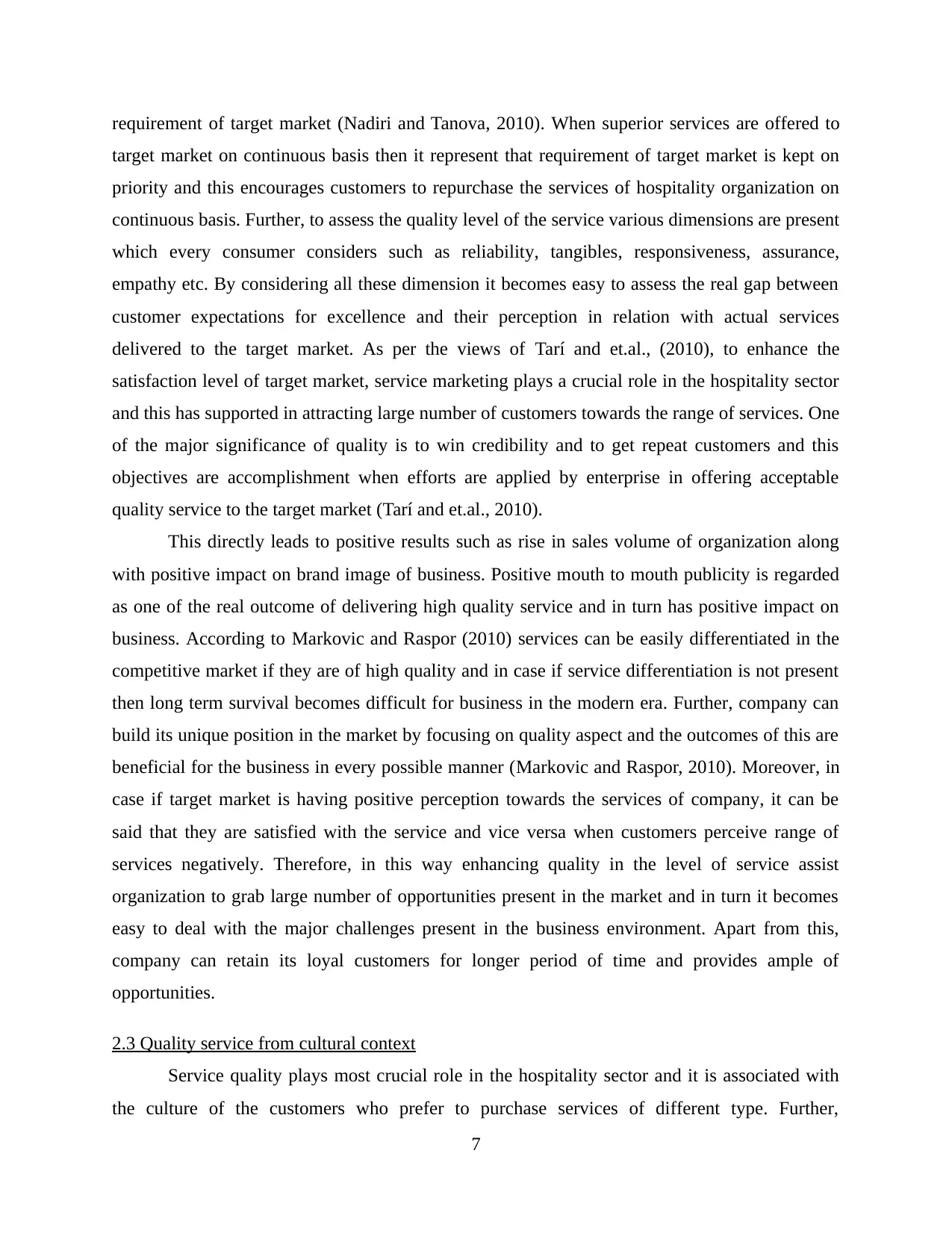
requirement of target market (Nadiri and Tanova, 2010). When superior services are offered to
target market on continuous basis then it represent that requirement of target market is kept on
priority and this encourages customers to repurchase the services of hospitality organization on
continuous basis. Further, to assess the quality level of the service various dimensions are present
which every consumer considers such as reliability, tangibles, responsiveness, assurance,
empathy etc. By considering all these dimension it becomes easy to assess the real gap between
customer expectations for excellence and their perception in relation with actual services
delivered to the target market. As per the views of Tarí and et.al., (2010), to enhance the
satisfaction level of target market, service marketing plays a crucial role in the hospitality sector
and this has supported in attracting large number of customers towards the range of services. One
of the major significance of quality is to win credibility and to get repeat customers and this
objectives are accomplishment when efforts are applied by enterprise in offering acceptable
quality service to the target market (Tarí and et.al., 2010).
This directly leads to positive results such as rise in sales volume of organization along
with positive impact on brand image of business. Positive mouth to mouth publicity is regarded
as one of the real outcome of delivering high quality service and in turn has positive impact on
business. According to Markovic and Raspor (2010) services can be easily differentiated in the
competitive market if they are of high quality and in case if service differentiation is not present
then long term survival becomes difficult for business in the modern era. Further, company can
build its unique position in the market by focusing on quality aspect and the outcomes of this are
beneficial for the business in every possible manner (Markovic and Raspor, 2010). Moreover, in
case if target market is having positive perception towards the services of company, it can be
said that they are satisfied with the service and vice versa when customers perceive range of
services negatively. Therefore, in this way enhancing quality in the level of service assist
organization to grab large number of opportunities present in the market and in turn it becomes
easy to deal with the major challenges present in the business environment. Apart from this,
company can retain its loyal customers for longer period of time and provides ample of
opportunities.
2.3 Quality service from cultural context
Service quality plays most crucial role in the hospitality sector and it is associated with
the culture of the customers who prefer to purchase services of different type. Further,
7
target market on continuous basis then it represent that requirement of target market is kept on
priority and this encourages customers to repurchase the services of hospitality organization on
continuous basis. Further, to assess the quality level of the service various dimensions are present
which every consumer considers such as reliability, tangibles, responsiveness, assurance,
empathy etc. By considering all these dimension it becomes easy to assess the real gap between
customer expectations for excellence and their perception in relation with actual services
delivered to the target market. As per the views of Tarí and et.al., (2010), to enhance the
satisfaction level of target market, service marketing plays a crucial role in the hospitality sector
and this has supported in attracting large number of customers towards the range of services. One
of the major significance of quality is to win credibility and to get repeat customers and this
objectives are accomplishment when efforts are applied by enterprise in offering acceptable
quality service to the target market (Tarí and et.al., 2010).
This directly leads to positive results such as rise in sales volume of organization along
with positive impact on brand image of business. Positive mouth to mouth publicity is regarded
as one of the real outcome of delivering high quality service and in turn has positive impact on
business. According to Markovic and Raspor (2010) services can be easily differentiated in the
competitive market if they are of high quality and in case if service differentiation is not present
then long term survival becomes difficult for business in the modern era. Further, company can
build its unique position in the market by focusing on quality aspect and the outcomes of this are
beneficial for the business in every possible manner (Markovic and Raspor, 2010). Moreover, in
case if target market is having positive perception towards the services of company, it can be
said that they are satisfied with the service and vice versa when customers perceive range of
services negatively. Therefore, in this way enhancing quality in the level of service assist
organization to grab large number of opportunities present in the market and in turn it becomes
easy to deal with the major challenges present in the business environment. Apart from this,
company can retain its loyal customers for longer period of time and provides ample of
opportunities.
2.3 Quality service from cultural context
Service quality plays most crucial role in the hospitality sector and it is associated with
the culture of the customers who prefer to purchase services of different type. Further,
7
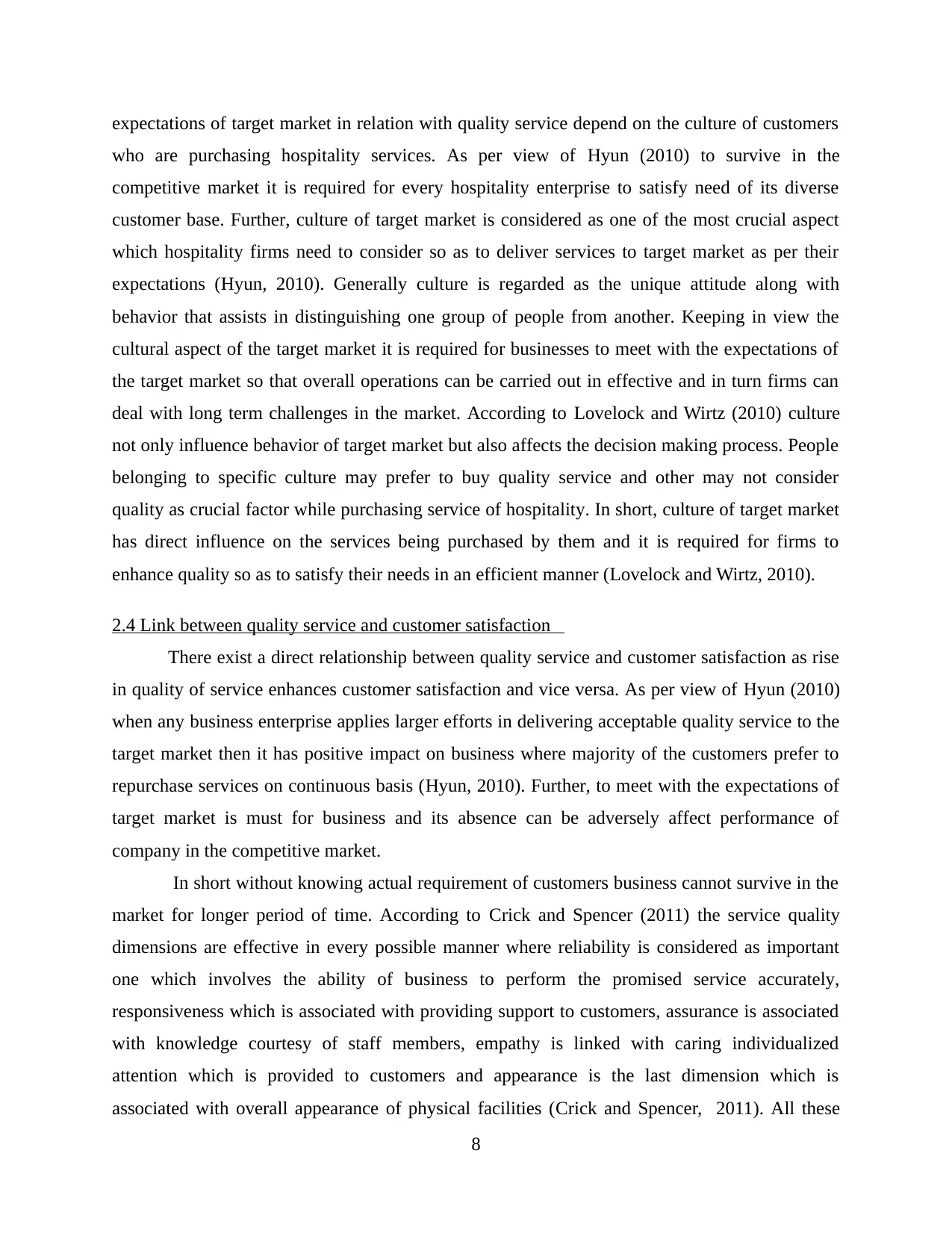
expectations of target market in relation with quality service depend on the culture of customers
who are purchasing hospitality services. As per view of Hyun (2010) to survive in the
competitive market it is required for every hospitality enterprise to satisfy need of its diverse
customer base. Further, culture of target market is considered as one of the most crucial aspect
which hospitality firms need to consider so as to deliver services to target market as per their
expectations (Hyun, 2010). Generally culture is regarded as the unique attitude along with
behavior that assists in distinguishing one group of people from another. Keeping in view the
cultural aspect of the target market it is required for businesses to meet with the expectations of
the target market so that overall operations can be carried out in effective and in turn firms can
deal with long term challenges in the market. According to Lovelock and Wirtz (2010) culture
not only influence behavior of target market but also affects the decision making process. People
belonging to specific culture may prefer to buy quality service and other may not consider
quality as crucial factor while purchasing service of hospitality. In short, culture of target market
has direct influence on the services being purchased by them and it is required for firms to
enhance quality so as to satisfy their needs in an efficient manner (Lovelock and Wirtz, 2010).
2.4 Link between quality service and customer satisfaction
There exist a direct relationship between quality service and customer satisfaction as rise
in quality of service enhances customer satisfaction and vice versa. As per view of Hyun (2010)
when any business enterprise applies larger efforts in delivering acceptable quality service to the
target market then it has positive impact on business where majority of the customers prefer to
repurchase services on continuous basis (Hyun, 2010). Further, to meet with the expectations of
target market is must for business and its absence can be adversely affect performance of
company in the competitive market.
In short without knowing actual requirement of customers business cannot survive in the
market for longer period of time. According to Crick and Spencer (2011) the service quality
dimensions are effective in every possible manner where reliability is considered as important
one which involves the ability of business to perform the promised service accurately,
responsiveness which is associated with providing support to customers, assurance is associated
with knowledge courtesy of staff members, empathy is linked with caring individualized
attention which is provided to customers and appearance is the last dimension which is
associated with overall appearance of physical facilities (Crick and Spencer, 2011). All these
8
who are purchasing hospitality services. As per view of Hyun (2010) to survive in the
competitive market it is required for every hospitality enterprise to satisfy need of its diverse
customer base. Further, culture of target market is considered as one of the most crucial aspect
which hospitality firms need to consider so as to deliver services to target market as per their
expectations (Hyun, 2010). Generally culture is regarded as the unique attitude along with
behavior that assists in distinguishing one group of people from another. Keeping in view the
cultural aspect of the target market it is required for businesses to meet with the expectations of
the target market so that overall operations can be carried out in effective and in turn firms can
deal with long term challenges in the market. According to Lovelock and Wirtz (2010) culture
not only influence behavior of target market but also affects the decision making process. People
belonging to specific culture may prefer to buy quality service and other may not consider
quality as crucial factor while purchasing service of hospitality. In short, culture of target market
has direct influence on the services being purchased by them and it is required for firms to
enhance quality so as to satisfy their needs in an efficient manner (Lovelock and Wirtz, 2010).
2.4 Link between quality service and customer satisfaction
There exist a direct relationship between quality service and customer satisfaction as rise
in quality of service enhances customer satisfaction and vice versa. As per view of Hyun (2010)
when any business enterprise applies larger efforts in delivering acceptable quality service to the
target market then it has positive impact on business where majority of the customers prefer to
repurchase services on continuous basis (Hyun, 2010). Further, to meet with the expectations of
target market is must for business and its absence can be adversely affect performance of
company in the competitive market.
In short without knowing actual requirement of customers business cannot survive in the
market for longer period of time. According to Crick and Spencer (2011) the service quality
dimensions are effective in every possible manner where reliability is considered as important
one which involves the ability of business to perform the promised service accurately,
responsiveness which is associated with providing support to customers, assurance is associated
with knowledge courtesy of staff members, empathy is linked with caring individualized
attention which is provided to customers and appearance is the last dimension which is
associated with overall appearance of physical facilities (Crick and Spencer, 2011). All these
8
⊘ This is a preview!⊘
Do you want full access?
Subscribe today to unlock all pages.

Trusted by 1+ million students worldwide
1 out of 37
Related Documents
Your All-in-One AI-Powered Toolkit for Academic Success.
+13062052269
info@desklib.com
Available 24*7 on WhatsApp / Email
![[object Object]](/_next/static/media/star-bottom.7253800d.svg)
Unlock your academic potential
Copyright © 2020–2025 A2Z Services. All Rights Reserved. Developed and managed by ZUCOL.





